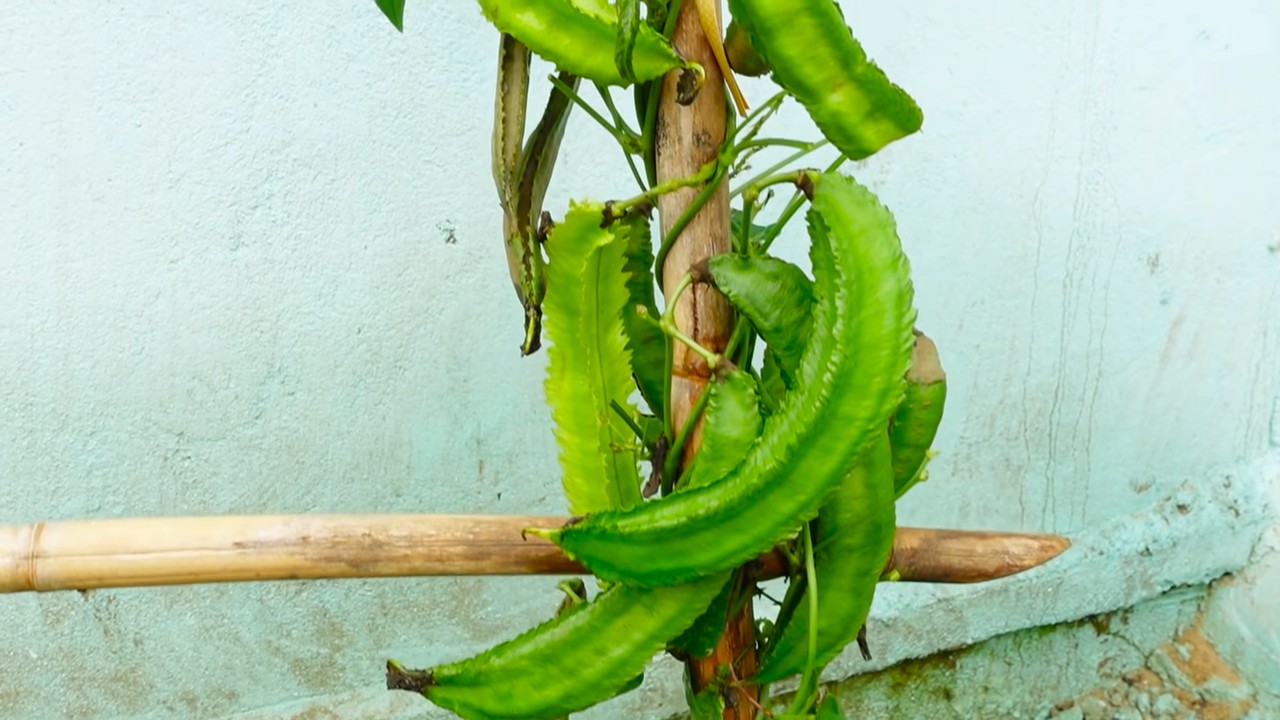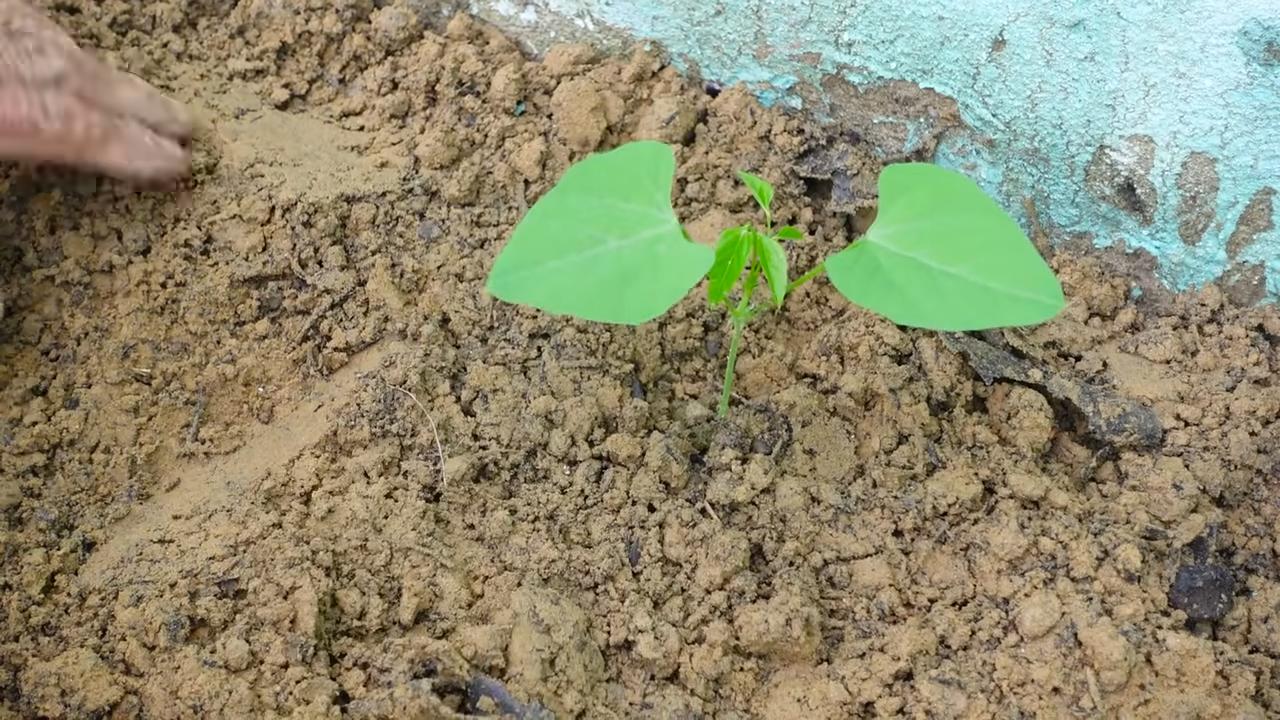Grow Dragon Beans at Home and unlock a world of vibrant color and delicious flavor right in your backyard! Have you ever seen those stunning, purple-streaked beans at the farmer’s market and thought, “Wow, I wish I could grow those!”? Well, guess what? You absolutely can! This isn’t just about growing beans; it’s about adding a touch of magic to your garden and your plate.
Beans, in general, have a rich history, dating back thousands of years and playing a vital role in cuisines across the globe. Dragon beans, with their unique appearance, bring a modern twist to this ancient staple. They’re not just pretty; they’re packed with nutrients and offer a delightful, slightly sweet flavor that’s perfect for salads, stir-fries, or simply steamed as a side dish.
But why should you bother with this DIY project? Because let’s face it, fresh, homegrown produce tastes infinitely better than anything you can buy at the store. Plus, grow dragon beans at home allows you to control exactly what goes into your food, avoiding harmful pesticides and ensuring the highest quality. In this article, I’ll share my tried-and-true tips and tricks for successfully cultivating these beauties, even if you’re a complete beginner. Get ready to impress your friends and family with your gardening prowess and enjoy the satisfaction of harvesting your own delicious dragon beans!

Drachenbohnen zu Hause anbauen: Dein umfassender DIY-Leitfaden
Hey Pflanzenfreunde! Habt ihr schon mal von Drachenbohnen gehört? Diese faszinierenden Kletterpflanzen mit ihren leuchtend roten, spiralförmigen Schoten sind nicht nur ein Hingucker, sondern auch relativ einfach zu Hause anzubauen. Ich zeige euch, wie ihr das ganz einfach selbst machen könnt!
Was sind Drachenbohnen überhaupt?
Drachenbohnen (Phaseolus coccineus ‘Scarlet Runner’) sind auch als Feuerbohnen bekannt. Sie sind nicht nur essbar (die jungen Schoten und die reifen Bohnen), sondern auch wunderschön anzusehen. Ihre leuchtend roten Blüten ziehen Bienen und andere nützliche Insekten an, und die langen, spiralförmigen Schoten sind einfach spektakulär. Sie sind also eine tolle Ergänzung für jeden Garten oder Balkon!
Was du brauchst: Die Materialliste
Bevor wir loslegen, hier eine Liste mit allem, was du für dein Drachenbohnen-Projekt benötigst:
* Drachenbohnensamen: Du bekommst sie in Gartencentern oder online. Achte darauf, dass sie frisch sind, um eine gute Keimrate zu gewährleisten.
* Anzuchttöpfe oder Eierkartons: Für die Voranzucht der Samen.
* Anzuchterde: Diese ist nährstoffarm und ideal für die Keimung.
* Größere Töpfe oder ein Beet: Für die ausgewachsenen Pflanzen.
* Gartenerde: Eine gute, nährstoffreiche Erde ist wichtig für das Wachstum.
* Kompost oder organischer Dünger: Um die Erde anzureichern.
* Rankhilfe: Drachenbohnen sind Kletterpflanzen und brauchen etwas zum Festhalten. Das kann ein Rankgitter, ein Zaun, ein Tipi oder ein selbstgebautes Gerüst sein.
* Gießkanne oder Schlauch: Zum Bewässern der Pflanzen.
* Pflanzschaufel: Zum Umtopfen und Einpflanzen.
* Ggf. Schneckenschutz: Schnecken lieben junge Drachenbohnenpflanzen.
Phase 1: Die Voranzucht der Samen
Die Voranzucht im Haus gibt deinen Drachenbohnen einen Vorsprung, besonders wenn du in einer Region mit kurzen Sommern lebst.
1. Die Samen vorbereiten: Um die Keimung zu beschleunigen, kannst du die Samen vor dem Einpflanzen für 24 Stunden in lauwarmem Wasser einweichen. Das macht die Samenschale weicher und erleichtert das Aufbrechen.
2. Die Anzuchttöpfe befüllen: Fülle deine Anzuchttöpfe oder Eierkartons mit Anzuchterde. Drücke die Erde leicht an.
3. Die Samen säen: Lege in jeden Topf oder jedes Fach 1-2 Samen. Bedecke sie mit etwa 2 cm Erde.
4. Angießen: Gieße die Erde vorsichtig an, sodass sie feucht, aber nicht nass ist.
5. Der richtige Standort: Stelle die Töpfe an einen warmen, hellen Ort. Eine Fensterbank ist ideal.
6. Feuchtigkeit halten: Halte die Erde feucht, indem du sie regelmäßig besprühst oder gießt. Vermeide Staunässe.
7. Geduld haben: Die Keimung dauert in der Regel 7-14 Tage.
Phase 2: Die Drachenbohnen auspflanzen
Sobald die jungen Pflanzen kräftig genug sind (etwa 10-15 cm hoch) und keine Frostgefahr mehr besteht, können sie ins Freie umziehen.
1. Den richtigen Zeitpunkt wählen: Warte, bis die Temperaturen konstant über 10°C liegen. Drachenbohnen sind frostempfindlich.
2. Den Standort vorbereiten: Wähle einen sonnigen Standort mit gut durchlässigem Boden. Drachenbohnen lieben die Sonne!
3. Die Erde vorbereiten: Lockere die Erde auf und mische Kompost oder organischen Dünger unter. Das sorgt für eine gute Nährstoffversorgung.
4. Die Rankhilfe installieren: Stelle sicher, dass deine Rankhilfe stabil und bereit ist, bevor du die Pflanzen einpflanzt.
5. Die Pflanzen umtopfen: Nimm die jungen Pflanzen vorsichtig aus ihren Anzuchttöpfen. Achte darauf, die Wurzeln nicht zu beschädigen.
6. Einpflanzen: Setze die Pflanzen in einem Abstand von etwa 20-30 cm in die Erde.
7. Angießen: Gieße die Pflanzen gründlich an.
8. An die Rankhilfe führen: Hilf den jungen Pflanzen, sich an der Rankhilfe festzuhalten.
Phase 3: Pflege und Ernte
Jetzt geht es darum, deine Drachenbohnen glücklich und gesund zu halten, damit sie reichlich tragen.
1. Regelmäßig gießen: Drachenbohnen brauchen viel Wasser, besonders während der Blütezeit und der Fruchtbildung. Achte darauf, dass die Erde immer feucht ist, aber vermeide Staunässe.
2. Düngen: Dünge die Pflanzen regelmäßig mit einem organischen Dünger oder Kompost. Das fördert das Wachstum und die Ernte.
3. Schnecken bekämpfen: Junge Drachenbohnenpflanzen sind ein gefundenes Fressen für Schnecken. Schütze sie mit Schneckenkorn oder anderen Schneckenabwehrmitteln.
4. Rankhilfe unterstützen: Kontrolliere regelmäßig, ob die Pflanzen sich gut an der Rankhilfe festhalten und hilf gegebenenfalls nach.
5. Blüten fördern: Entferne verwelkte Blüten, um die Bildung neuer Blüten und Schoten anzuregen.
6. Ernten: Du kannst die jungen, zarten Schoten ernten, sobald sie etwa 15-20 cm lang sind. Sie sind dann noch weich und haben keine harten Fäden. Die reifen Bohnen kannst du ernten, wenn die Schoten trocken und braun sind.
7. Regelmäßige Ernte: Durch regelmäßiges Ernten der Schoten förderst du die Bildung neuer Schoten.
Tipps und Tricks für eine reiche Ernte
* Sonniger Standort: Drachenbohnen lieben die Sonne. Je mehr Sonne sie bekommen, desto besser werden sie tragen.
* Gute Drainage: Achte darauf, dass der Boden gut durchlässig ist, um Staunässe zu vermeiden.
* Regelmäßiges Gießen: Drachenbohnen brauchen viel Wasser, besonders während der Blütezeit und der Fruchtbildung.
* Regelmäßiges Düngen: Dünge die Pflanzen regelmäßig mit einem organischen Dünger oder Kompost.
* Schneckenabwehr: Schütze die jungen Pflanzen vor Schnecken.
* Rankhilfe: Stelle sicher, dass die Rankhilfe stabil und ausreichend hoch ist.
* Regelmäßige Ernte: Durch regelmäßiges Ernten der Schoten förderst du die Bildung neuer Schoten.
* Bohnen für das nächste Jahr aufbewahren: Lasse einige Schoten an der Pflanze trocknen und ernte die Bohnen, um sie für das nächste Jahr aufzubewahren.
Häufige Probleme und Lösungen
* Gelbe Blätter: Können ein Zeichen für Nährstoffmangel oder Staunässe sein. Dünge die Pflanzen oder verbessere die Drainage.
* Schneckenbefall: Schütze die Pflanzen mit Schneckenkorn oder anderen Schneckenabwehrmitteln.
* Blattläuse: Bekämpfe Blattläuse mit einem natürlichen Insektizid oder spüle sie mit einem starken Wasserstrahl ab.
* Keine Blüten: Kann ein Zeichen für zu wenig Sonne oder zu viel Stickstoff im Boden sein. Stelle die Pflanzen an einen sonnigeren Standort oder dünge mit einem Dünger mit weniger Stickstoff.
Drachenbohnen in der Küche
Drachenbohnen sind vielseitig verwendbar. Die jungen Schoten können wie grüne Bohnen gekocht, gedünstet oder gebraten werden. Die reifen Bohnen können getrocknet und als Eintopfzutat verwendet werden. Sie sind reich an Proteinen und Ballaststoffen.
* Junge Schoten: Kochen, dünsten, braten, in Salaten verwenden.
* Reife Bohnen: Als Eintopfzutat, in Suppen, als Beilage.
Ich hoffe, dieser Leitf

Conclusion
So, there you have it! Growing dragon beans at home is not only achievable but also incredibly rewarding. Forget those expensive, often lackluster, store-bought beans. With a little patience and our simple guide, you can cultivate your own vibrant, delicious, and visually stunning dragon beans right in your backyard or even on your balcony.
Why is this DIY trick a must-try? Because it puts you in control. You know exactly what goes into your food – no harmful pesticides, no questionable growing practices, just pure, homegrown goodness. Plus, the satisfaction of harvesting something you nurtured from a tiny seed is unparalleled. Imagine the look on your friends’ and family’s faces when you serve them a dish featuring your own homegrown dragon beans!
But the benefits don’t stop there. Growing dragon beans is also a fantastic way to connect with nature, learn about the growing process, and even get some exercise. It’s a hobby that’s both productive and therapeutic.
Ready to take your dragon bean cultivation to the next level? Consider these variations:
* Trellis Designs: Experiment with different trellis designs to create a visually stunning vertical garden. Think arches, teepees, or even repurposed materials for a rustic touch.
* Companion Planting: Dragon beans thrive alongside certain plants. Try planting them with carrots, cucumbers, or marigolds to deter pests and improve growth.
* Seed Saving: Once you’ve successfully grown your dragon beans, save some seeds for future planting. This ensures a continuous supply of your favorite beans and allows you to adapt the variety to your specific climate.
* Different Varieties: While we’ve focused on the classic dragon bean, explore other pole bean varieties with unique colors and flavors. ‘Kentucky Wonder’ or ‘Blue Lake’ are excellent choices for comparison.
We’re confident that you’ll find growing dragon beans at home to be a delightful and fulfilling experience. Don’t be afraid to experiment, adapt our guide to your specific needs, and most importantly, have fun!
Now, we want to hear from you! Have you tried growing dragon beans at home before? What challenges did you face? What successes did you celebrate? Share your experiences in the comments below. Your insights can help other aspiring dragon bean growers on their journey. And if you’re just starting out, we’re here to support you every step of the way. So, grab some seeds, get your hands dirty, and prepare to be amazed by the magic of homegrown dragon beans! Let us know how your dragon bean adventure unfolds!
Frequently Asked Questions (FAQ)
What exactly are dragon beans, and why should I grow them?
Dragon beans, also known as ‘Borlotti’ beans, are a type of pole bean prized for their beautiful mottled pods and creamy, nutty flavor. They are a fantastic choice for home gardeners because they are relatively easy to grow, produce a high yield, and offer a unique visual appeal. Growing them yourself ensures you have access to fresh, pesticide-free beans, and it’s a rewarding experience to nurture them from seed to harvest. Plus, they are a conversation starter!
How much space do I need to grow dragon beans?
Dragon beans are pole beans, meaning they require vertical support to climb. While they don’t take up a lot of ground space, you’ll need to provide a trellis, fence, or other structure that is at least 6-8 feet tall. The spacing between plants should be about 6-8 inches apart along the base of the trellis. A small garden bed or even a large container can be sufficient for a few plants.
What kind of soil is best for dragon beans?
Dragon beans prefer well-drained soil that is rich in organic matter. Before planting, amend your soil with compost or well-rotted manure to improve its fertility and drainage. A slightly acidic to neutral pH (around 6.0-7.0) is ideal. If your soil is heavy clay, consider adding sand or perlite to improve drainage.
How often should I water my dragon beans?
Dragon beans need consistent moisture, especially during flowering and pod development. Water deeply whenever the top inch of soil feels dry to the touch. Avoid overwatering, as this can lead to root rot. Mulching around the base of the plants can help retain moisture and suppress weeds.
What are some common pests and diseases that affect dragon beans, and how can I prevent them?
Common pests include aphids, bean beetles, and spider mites. Regularly inspect your plants for signs of infestation and take action promptly. Insecticidal soap or neem oil can be effective for controlling these pests. Diseases like powdery mildew and bean rust can also affect dragon beans. Ensure good air circulation around the plants and avoid overhead watering to minimize the risk of these diseases. Consider using disease-resistant varieties if these problems are prevalent in your area.
When is the best time to harvest dragon beans?
You can harvest dragon beans at two stages: as snap beans when the pods are young and tender, or as dry beans when the pods are mature and dry. For snap beans, harvest when the pods are about 6-8 inches long and the beans inside are still small. For dry beans, allow the pods to dry completely on the vine. Once dry, shell the beans and store them in an airtight container.
Can I grow dragon beans in containers?
Yes, you can successfully grow dragon beans in containers, provided you choose a large enough container (at least 12 inches in diameter and depth) and provide adequate support for the vines. Use a well-draining potting mix and ensure the container receives plenty of sunlight. Water regularly and fertilize as needed.
How do I save seeds from my dragon beans?
To save seeds, allow the pods to dry completely on the vine. Once dry, shell the beans and spread them out on a screen or tray to air dry for a few more days. Store the dried beans in an airtight container in a cool, dark, and dry place. Properly stored seeds can remain viable for several years.
Are dragon beans nitrogen fixers?
Yes, like other legumes, dragon beans are nitrogen fixers. They have a symbiotic relationship with bacteria in the soil that convert atmospheric nitrogen into a form that plants can use. This means that growing dragon beans can actually improve the soil fertility in your garden.
What are some delicious ways to cook with dragon beans?
Dragon beans are incredibly versatile in the kitchen. They can be used in soups, stews, salads, and stir-fries. They are also delicious simply boiled or steamed and served with butter and herbs. Their creamy texture and nutty flavor make them a great addition to any dish. Try them in a classic Italian pasta e fagioli or as a side dish with roasted meats.




Leave a Comment